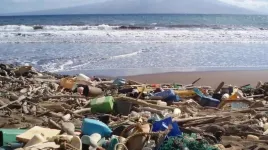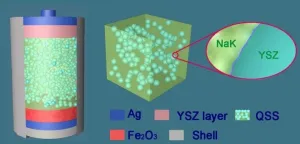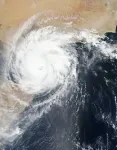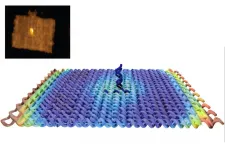Land-use to solve climate change: a focus on livestock
2021-02-01
(Press-News.org) Greenhouse gas (GHG) emissions from agriculture, forestry and other land uses (AFOLU sector) cover the 24% of global emissions, representing the second hot spot in the contribution to climate change after the energy sector.
The main drivers are CO2 emissions from deforestation, methane (CH4) emissions produced by ruminant livestock and by anaerobic fermentation of organic matter, mainly from rice crops, and nitrous oxide (N2O) emissions from fertilizer use. Thus, the land sector plays a crucial role in the contribution to climate change.
A new study lead by the CMCC Foundation explores to which extent sustainable land management options applied at small-scale rural landscape level can be a valuable solution for increasing the mitigation potential of the land sector. In particular, possible land-based mitigation options are identified to reduce and offset GHG emissions from the livestock sector that represents one of the main sources of GHG emissions of the whole agricultural sector. Although GHG emissions from the livestock sector decreased since 1990, with ?20% in Europe in 2018, they still contribute to more than 60% to the total agricultural emissions at European level.
"The land sector", explains Maria Vincenza Chiriacò, CMCC researcher and lead author of the study, "has the unique characteristic to be at the same time both a contributor to climate change and part of its solution, thanks to the carbon sink function in soils and biomass that can be enhanced by an appropriate and sustainable land management. Our proposed land-based approach consists of two consecutive steps: we assess first the GHG emissions from the livestock activities, that is carbon footprint, in a small-scale rural area, then we evaluate the mitigation potential of a set of land-use options against livestock emissions assessed in the previous step. Our aim is to understand the extent to which land-based mitigation options at small-scale landscape level can lead to carbon neutral livestock systems".
CMCC scientists developed a land-based approach by combining different methodologies, including geographic information system (GIS) elaboration, life cycle assessment (LCA) and methodologies from the Intergovernmental Panel on Climate Change (IPCC), to investigate how and how much GHG emissions from livestock activities can be decreased and compensated through carbon removals in the same area. They tested the approach on a pilot area in central Italy corresponding to a portion of the Municipality of Viterbo (Lazio region) characterized by a strong agricultural vocation, aiming at estimating the livestock GHG emissions and the mitigation potential of sustainable land-use options applied in the same small-scale rural landscape, in the immediate proximity of the livestock emissions source.
"The results", Prof. Riccardo Valentini (CMCC Foundation and University of Tuscia) says, "show the potential for a total offsetting of the livestock GHG emissions in the pilot area, indicating possible pathways for the carbon neutral livestock systems. Besides, depending on the type and intensity of the land-based mitigation options, results undermine also the possibility to even turn the system into a net carbon sink, producing negative emissions in the land sector that can significantly contribute to the global climate change mitigation targets."
"It's important to highlight", Maria Vincenza Chiriacò adds, "the idea of proximity of our land-based approach. There are already many existing mechanisms of carbon offsetting but they work on a logic of carbon compensation on a global scale, where the carbon removals usually take place in areas that are geographically far from those in which the emissions to be compensated are generated. In our study, instead, mitigation is achieved through the implementation of land-based mitigation options that reduce emissions or increase carbon sink in the immediate proximity of the livestock GHG emissions source. This, besides contributing to the global climate change mitigation targets, entails a wide-ranging improvement of the entire agro-ecosystem at local scale, providing co-benefits that involve the local rural communities as well as the local institutions and the citizens that can gain in terms of environmental co-benefits, quality of life and territorial image."
The proposed land-based approach has been recently developed in a web tool. Designed and developed by the CMCC and Istituto di Servizi per il Mercato Agricolo Alimentare (ISMEA), with the financial support of the Programme "Rete Rurale Nazionale 2014-2020", the tool is freely available online. The web tool is based on rigorous scientific information (IPCC methodology), but it's designed to be easy to use for everyone.
The platform allows Italian livestock farmers to assess the carbon footprint of their farms by compiling a simple online questionnaire that considers the main characteristics of their livestock systems. Then, they can also assess the potential of sustainable land-based options needed to reduce and compensate their livestock emissions. Therefore, the web tool will help farmers, policy makers, and other relevant stakeholders in recognizing the best options to be applied for sustainable land management in particular at small-scale rural landscape level.
CMCC researchers aim to develop in collaboration with ISMEA and the Programme "Rete Rurale Nazionale 2014-2020" a traceability system for sustainable land-use leveraging on the developed land-based approach, through a voluntary mechanism of carbon farming practices at local level, aiming at reducing and offsetting GHG emissions from the livestock activities in Italy.
Hence, this mechanism has the potential to reduce and compensate the impacts caused by livestock products, making farmers and rural systems an important target for climate change mitigation.
INFORMATION:
The land-based approach presented in this study was developed in the framework of the Programme "Rete Rurale Nazionale 2014-2020" activities thanks to a specific agreement between the CMCC Foundation Euro-Mediterranean Center on Climate Change (CMCC) and Istituto di Servizi per il Mercato Agricolo Alimentare (ISMEA), within the project Il distretto agricolo-zootecnico-forestale: un nuovo approccio territoriale per la mitigazione dei cambiamenti climatici.
Read and download the full paper (free download until February 23, 2021):
Maria Vincenza Chiriacò, Riccardo Valentini, A land-based approach for climate change mitigation in the livestock sector, Journal of Cleaner Production, Volume 283, 2021,
124622, ISSN 0959-6526,
https://doi.org/10.1016/j.jclepro.2020.124622.
ELSE PRESS RELEASES FROM THIS DATE:
2021-02-01
That is the question that Prof. Alan Deidun, resident academic within the Department of Geosciences of the Faculty of Science, along with a cohort of high-profile co-authors, posed within a study recently published in the Microplastics and Nanoplastics journal. Specifically, the study overviews a plethora of marine litter monitoring survey data available for different regions of the world ocean, as well as modelling data, in order to answer this compelling question.
The study, whose lead author is renowned litter researcher Dr Francois Galgani from IFREMER, concludes that, despite the well-known increase in the volume of plastics making their way ...
2021-02-01
The impact of ozone on soybean production can be predicted more accurately thanks to improvements to a computer modelling system.
Surface ozone is a pollutant that affects plant growth by entering leaves and reducing the rate of photosynthesis, and rising ozone levels could severely limit production of crops including soy.
Being able to estimate this damage on soybean production using a "climate-vegetation model" is vital for predicting global and regional soy yields in the future.
This study uses results from a field experiment in the USA, which found that a normal ozone level of 10ppm/h (AOT40) could reduce soybean yield by 10%.
At extreme ozone levels - comparable to those observed on very polluted days in some parts of the world - soybean production fell to less than ...
2021-02-01
Increases in life expectancy in the UK and elsewhere had slowed even before 2016 - and COVID-19 is expected to further eliminate any gains, Newcastle University studies show.
After 2011, over the post-financial crisis period the authors find that the UK performed poorly, in almost all measures, compared to the 28 countries of the European Union (EU28).
Life expectancy at birth, and age 65, in the UK were increasing rapidly in 2008 but slowed around 2011 and Germany, Portugal and France showed evidence of a similar slowing.
Furthermore, years of good health, called Healthy Life Years, at birth in the UK decreased, whereas it increased in most EU28 countries. The UK experienced a period ...
2021-02-01
Using salt as a key ingredient, Chinese and British researchers have designed a new type of rechargeable battery that could accelerate the shift to greener, electric transport on our roads.
Many electric vehicles (EV) are powered by rechargeable lithium-ion batteries, but they can lose energy and power over time. Under certain conditions, such batteries can also overheat while working or charging, which can also degrade battery life and reduce miles per charge.
To solve these issues, the University of Nottingham is collaborating with six scientific ...
2021-02-01
The year 2020 played host to an uncharacteristically large number of natural disasters. The year began with large wildfires in the Amazon rainforest and Australia. A series of wildfires broke out in the American states of California during summer and Oregon in September 2020. In particular, the Oregon wildfire intensified to an uncontrollable extent and was spread over a wide area by strong gusts of wind that carried it forward. These unseasonably strong winds may have been stoked by an unexpected source: typhoons on the other side of the Pacific Ocean.
In late August and early September, three storms--Bavi, Mayask, and Haishen--occurred just two weeks apart in the Korean peninsula, causing floods, mudslides, and several casualties. In a recently ...
2021-02-01
T-cells are an important component of our immune system: with the receptors they carry on their surface, they can recognise highly specific antigens. Upon detection of an intruder, an immune response is triggered. It is still unclear exactly what happens when antigens are recognised: How many antigens are necessary to elicit an immune response, and does the response depend on their spatial arrangement?
These effects take place in the nanometer range - on the size scale of molecules, far below what can be seen with ordinary microscopes. To study all this, tiny tools are needed. Therefore, an unusual method was used at TU Wien: DNA molecules were folded in an ingenious way, similar to the paper folding ...
2021-02-01
Students from lower socio-economic groups (SEG) are less likely to participate in sport or physical activity at university, research from Sheffield Hallam University has found.
The main barriers affecting participation were found to be down to cost of being part of a sports team, lack of time due to academic commitments, part-time working or their social life taking precedence and limited prior knowledge of and participation in sport before starting university.
Funded by British Universities and Colleges Sport and published in the peer-reviewed Sport, Education and Society journal, the study surveyed over 700 students from 20 universities and found those that had participated in sport and physical ...
2021-02-01
A collaboration between the Pericàs group with Prof. Timothy Noël and Dr. Paola Riente at the Eindhoven University of Technology (TU/e, The Netherlands), has crystallised in a Nature Communications paper where they provide key insight into the chemical nature of the true photocatalyst involved in the Bi2O3-driven atom-transfer radical addition (ATRA) reaction.
Back in 2014, ICREA professors Miquel Pericàs and Emilio Palomares together with former postdoctoral researcher Dr. Riente published a paper on Angewandte Chemie International Edition pioneering the research on organic transformations in mild reactions conditions ...
2021-02-01
The work of the research group under the guidance of Professor Leonid Martyushev (co-authors: Roman Bando and Evgenia Chervontseva) will help to predict the behavior of fluids in various environments.
"When oil wells are depleted, water is pumped there under pressure to force the residual oil to the surface. If the interface between water and oil were an even layer, then it would be safe to say that as a result of water injection we recover all the residual oil. But since the interface between the two liquids is a highly distorted section, oil, contrary to expectations, can still remain underground, while water comes out to the surface. This is where our calculations come in ...
2021-02-01
The coronavirus crisis has led to some of the general public developing a critical view of the current food consumption model, as shown by a recent survey by the Catalan Consumer Agency, which reveals that 60.5% of all Catalans tend to think that the pandemic will promote more responsible, sustainable and fair consumption. Moreover, the various lockdowns have caused a significant increase in online shopping throughout Spain, with a 92% rise in volume and a 114.5% rise in value, according to aggregated consumption data from the Ministry of Agriculture, Fisheries and Food. This change in shopping habits and the awareness of the food model may also ...
LAST 30 PRESS RELEASES:
[Press-News.org] Land-use to solve climate change: a focus on livestock




